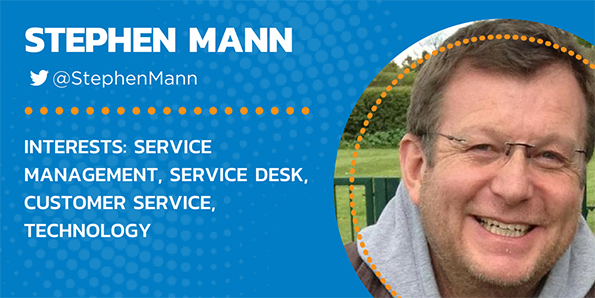Date Published July 11, 2017 - Last Updated December 6, 2017
In January 2017, HDI presented the Top 25 Thought Leaders in Technical Support and Service Management. To help you get to know them better and learn what it means to be a community leader, we’ve interviewed each of our thought leaders. Today, we hear from Stephen Mann.

Tell us about your day job and also how you are involved in the community.
I write stuff about, and occasionally present on, ITSM and the surrounding areas/topics. So most of the day, I’m at a PC creating content either for ITSM tool vendors—such as blogs, eBooks, white papers, webinars, and case studies—or writing/editing content for ITSM.tools, a still relatively new ITSM community website that covers ITSM and customer service best practices through to the tools that support them.
What motivates you to be active in the community?
I believe that we still have so much to do as ITSM professionals and that we can’t do it alone or with just a set of best practice books. I wrote about it in 2011 while an industry analyst at Forrester; this was the origin of the Back2ITSM Facebook group. Plus, the corporate IT goalposts continue to move as consumer-world IT, service delivery, support, customer service, and customer experience advance.
It helps that I love writing about ITSM—I consider myself to be more of a content aggregator and presenter than an ITSM expert—and, while much of what I do is paid for by vendors, I feel the need to share other information in an independent way (whether written by me or others).
It’s not just the writing though. Participating in the ITSM community via social media and at industry events is always rewarding, too. You can learn so much by listening rather than talking.
What suggestions do you have for tech support professionals interested in getting more involved in the community?
Definitely try to be more engaged on social media. Yes, there’s a lot of “We sell this, you should buy it!” stuff out there. But if you follow the right people, you have access to a wealth of knowledge through just a few clicks. You don’t have to be full-on engaged; many people start by just listening and are happy for that to be the extent of their social media engagement. Here are a few good places to start:
Plus, if you can afford the time and cost, try to attend an ITSM industry event. The value lies not only in the presentations but also in the conversations, from posing challenging questions to the sponsors in the expo area (they are there to help as well as to sell) to the informal networking from which you will learn much and possibly identify your next career move.
What trends do you anticipate for enterprise service management over the next few years?
Enterprise service management is everywhere now, but many people might not realize that they have already adopted it. They are “just using the corporate ITSM tool elsewhere.”
In terms of where it is going, I see the following happening:
- The name will be replaced with something more palatable to other lines of business such as digital transformation, the digital workplace, the digital back office, or the digital backbone.
- In doing this, more organizations will understand that digital transformation has three parts: new (digital) products and services, improved customer touchpoints, AND the improvement of business processes and operations.
- The change in name will also allow enterprise service management to morph into something new that will then bring new thinking and capabilities back into IT.
- Enterprise service management will grow beyond the service-desk-associated capabilities, taking on more of the ITIL service lifecycle, including service strategy and CSI. It should have already but many organizations are still too focused on a finite number of reactive ITSM/ITIL processes.
- External customer service will see a strong uptake of enterprise service management (in addition to the oft-quoted HR and facilities). This, in particular, will feed back more into IT operations.
Enterprise service management will grow beyond the service-desk-associated capabilities.

Amy Eisenberg is the editor for HDI where she works with industry experts and practitioners to create content for technical support professionals. She has worked in B2B media and scholarly publishing for more than 20 years, developing content for print and digital magazines, print and email newsletters, websites, conferences, and technical seminars. Follow Amy on Twitter @eisenbergamy, and connect with her on LinkedIn.